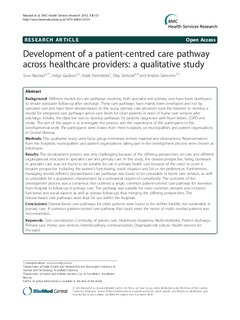Development of a patient centred care pathway across health care providers: a qualitative study
Journal article, Peer reviewed
Permanent lenke
http://hdl.handle.net/11250/300590Utgivelsesdato
2013Metadata
Vis full innførselSamlinger
Sammendrag
Background: Different models for care pathways involving both specialist and primary care have been developed
to ensure adequate follow-up after discharge. These care pathways have mainly been developed and run by
specialist care and have been disease-based. In this study, primary care providers took the initiative to develop a
model for integrated care pathways across care levels for older patients in need of home care services after
discharge. Initially, the objective was to develop pathways for patients diagnosed with heart failure, COPD and
stroke. The aim of this paper is to investigate the process and the experiences of the participants in this
developmental work. The participants were drawn from three hospitals, six municipalities and patient organizations
in Central Norway.
Methods: This qualitative study used focus group interviews, written material and observations. Representatives
from the hospitals, municipalities and patient organizations taking part in the development process were chosen as
informants.
Results: The development process was very challenging because of the differing perspectives on care and different
organizational structures in specialist care and primary care. In this study, the disease perspective, being dominant
in specialist care, was not found to be suitable for use in primary health care because of the need to cover a
broader perspective including the patient’s functioning, social situation and his or her preferences. Furthermore,
managing several different disease-based care pathways was found to be unsuitable in home care services, as well
as unsuitable for a population characterized by a substantial degree of comorbidity. The outcome of the
development process was a consensus that outlined a single, common patient-centred care pathway for transition
from hospital to follow-up in primary care. The pathway was suitable for most common diseases and included
functional and social aspects as well as disease follow-up, thus merging the differing perspectives. The
disease-based care pathways were kept for use within the hospitals.
Conclusions: Disease-based care pathways for older patients were found to be neither feasible nor sustainable in
primary care. A common patient-centred care pathway that could meet the needs of multi- morbid patients was
recommended.
Keywords: Care coordination, Continuity of patient care, Healthcare disparities, Multi-morbidity, Patient discharge,
Primary care, Home care services, Interdisciplinary communication, Organizational culture, Health services for
the aged.
